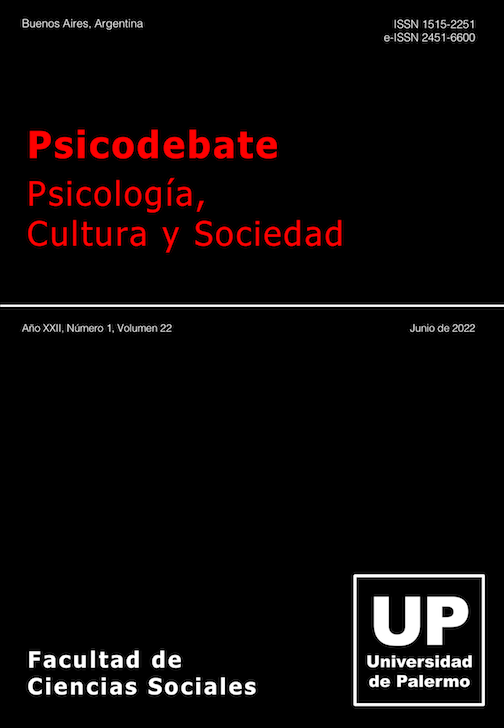Adaptation of the General Causality Orientations Scale for University Students
Abstract
The goal of this study was to adapt the General Causality Orientations Scale, aimed at the assessment of global motivation, within university population. Participants were 364 students between 18 and 35 years old from the University of Buenos Aires (62.6% female, 37.4% male; Mage = 22.97, SDage = 3). Data were collected with a sociodemographic and academic survey, the Academic Motivation Scale, and the General Causality Orientations Scale. At first, conceptual and linguistic adaptation was carried out from the translation and analysis of the content of the test items. Through an exploratory factor analysis employing Minimum Rank Factor Analysis (MRFA) as extraction method with a direct Oblimin oblique rotation, a 15-item structure grouped into three factors (Autonomous, Controlled, Impersonal) was found, explaining 67.7% of the variance. Internal consistency, estimated with ordinal alphas, was adequate (α = .71/.81). Also, evidence of criterion validity was provided with the Academic Motivation Scale. Finally, a test-retest analysis provided evidence regarding temporal stability of the scores. In conclusion, assessment technology is conveyed through the local adaptation of a global measure of motivation with appropriate psychometric quality and suitable for its use with college students.
Downloads
References
American Psychological Association (2010). Ethical principles of psychologists and code of conduct. https://www.apa.org/ethics/code/index
Brenlla, M. E., Messina, V. M., & Aranguren, M. (2013). Adaptación para Buenos Aires de la Escala de Orientaciones Causales (General Causality Orientations Scale – GCOS). Interdisciplinaria, 30(1), 65-84. https://doi.org/10.16888/interd.2013.30.1.4
Bruno, F. E., Fernández Liporace, M., & Stover, J. B. (2020). Escala de Motivación Situacional Académica para estudiantes universitarios: desarrollo y análisis psicométricos. Interdisciplinaria, 37(1), 129-144. https://doi.org/10.16888/http://dx.doi.org/10.16888/interd.2020.37.1.8
Cohen, J. (1988). Statistical power analysis for the behavioral sciences. (2d Edition). Lawrence Erlbaum Associates.
Cooper, S., Lavaysse, L. M., & Gard, D. E. (2015). Assessing motivation orientations in schizophrenia: Scale development and validation. Psychiatric Research, 225(1), 70-78. https://doi.org/10.1016/j.psychres.2014.10.013
deCharms, R. (1968). Personal causation: The internal affective determinants of behavior. Academic Press.
Deci, E. L., & Ryan, R. M. (1985a). Intrinsic Motivation and self-determination inhuman behavior. Plenum Press. https://doi.org/10.1007/978-1-4899-2271-7
Deci, E. L., & Ryan, R. M. (1985b). The General Causality Orientations Scale: Self -Determination in Personality. Journal of Research in Personality, 19, 109-134. https://doi.org/10.1016/0092-6566(85)90023-6
Deci, E. L., & Ryan, R. M. (2004). Handbook of self-determination research. University of Rochester Press.
Deponte, A. (2004). Linking motivation to personality: Causality orientations, motives and self-descriptions. European Journal of Personality, 18, 31–44. https://doi.org/10.1002/per.503
Domínguez-Lara, S. (2018). Fiabilidad y alfa ordinal. Actas urológicas españolas, 42(2), 140-141. https://doi.org/10.1016/j.acuro.2017.07.002
Elosúa, P., & Zumbo, B. D. (2008). Coeficientes de confiabilidad para escalas de respuesta categórica ordenada. Psicothema, 20(4), 896-901.
Hagger, M. S., & Hamilton, K. (2021). General causality orientations in self-determination theory: metanalysis and test of a process model. European Journal of Personality, 35(5), 710-735. https://doi.org/10.31234/osf.io/hbs3k
Hernández Sampieri, R., Collado, C. F., & Baptista Lucio, M. P. (2010). Metodología de la Investigación. (5ta Edición). Mc Grawn Hill.
Howard, J. L., Gagné, M., & Bureau, J. S. (2017). Testing a continuum structure of self-determined motivation: A Meta-Analysis. Psychological Bulletin, 143, 1346-1377. https://doi.org/10.1037/bul0000125
Lavigne, G. L., & Vallerand, R. J. (2010) The dynamic processes of influence between contextual and situational motivation: A test of the hierarchical model in a science education setting. Journal of Applied Social Psychology, 40, 2343-2359. https://doi.org/10.1111/j.1559-1816.2010.00661.x
Lei, W., Liu, K., Li, N., Liang, X, Xiang, B., Huang, C., Zhang, J., Zheng, X., & Cheng, J. (2019). Validation of the Chinese version General Causality Orientation Scale‐Clinical Population and causality orientations assessing in major depressions. Asia-Pacific Psychiatry, 11(3), e12348. https://doi.org/10.1111/appy.12348
Lloret-Segura, S., Ferreres-Traver, A., Hernández-Baeza, A., & Tomás-Marco, I. (2014). El análisis factorial exploratorio de los ítems: una guía práctica, revisada y actualizada. Anales de Psicología, 30(3), 1151-1169. https://doi.org/10.6018/analesps.30.3.199361
Lorenzo-Seva, U., & Ferrando, P. J. (2013). FACTOR 9.2. A Comprehensive Program for Fitting Exploratory and Semiconfirmatory Factor Analysis and IRT Models. Applied Psychological Measurement, 37(6), 497-498. https://doi.org/10.1177/0146621613487794
Ministerio de Educación, Secretaría de Políticas Universitarias. (2013). Anuario 2013. Estadísticas Universitarias. http://informacionpresupuestaria.siu.edu.ar/DocumentosSPU/Anuario_2013.pdf
Muthén, B., & Kaplan D. (1985). A comparison of some methodologies for the factor analysis of non-normal Likert variables. British Journal of Mathematical and Statistical Psychology, 38, 171-189. https://doi.org/10.1111/j.2044-8317.1985.tb00832.x
Núñez, J. L., & León, J. (2018). Probando las relaciones entre la motivación global, contextual y situacional: un estudio longitudinal de los efectos horizontal, arriba-abajo y abajo-arriba. Revista de Psicodidáctica,23(1), 9-16. https://doi.org/10.1016/j.psicod.2017.07.003
Olesen, M. H. (2011). General causality orientations are distinct from but related to dispositional traits. Personality and Individual Differences, 52(4), 460-465. https://doi.org/10.1016/j.paid.2011.04.015
Olesen, M. H., Thomsen, D. K., Schnieber, A., & Tønnesvang, J. (2010). Distinguishing general causality orientation from personality traits. Personality and Individual Differences, 48(5), 538-543. https://doi.org/10.1016/j.paid.2009.11.032
Rose, E. A., Markland, D., & Parffit, G. (2001). The development and initial validation of the Exercise Causality Orientations Scale. Journal of Sports Sciences, 19(6), 445-462. https://doi.org/10.1080/026404101300149393
Ryan, M. R., & Deci, E. L. (2000). Self-determination theory and the facilitation of intrinsic motivation, social development, and well-being. American Psychological, 55(1), 68-78. https://doi.org/10.1037/0003-066X.55.1.68
Ryan, R. M., & Deci, E. L. (2017). Self-Determination Theory. Basic Psychological Needs in Motivacion, Development and Wellness. Guilford Press. https://doi.org/10.1521/978.14625/28806
Şen, G., & Dag, I. (2016). The Turkish adaptation, validity and reliability study of General Causality Orientations Scale in a university sample. Anatolian Journal of Psychiatry, 17(1), 100-107. https://doi.org/10.5455/apd.204169
SPSS INC. (2009). PASW Statistics for Windows, Version 18.0. SPSS Inc.
Stover, J. B., de la Iglesia, G., Rial Boubeta, A., & Fernández Liporace, M. (2012). Academic motivation scale (AMS): Adaptation and psychometric analyses for high school and college students. Psychology Research and Behavior Management, 5, 71-83. https://doi.org/10.2147/PRBM.S33188
Timmerman, M. E., & Lorenzo-Seva, U. (2011). Dimensionality assessment of ordered polytomous items with parallel analysis. Psychological Methods, 16(2), 209-220. https://doi.org/10.1037/a0023353
Tkhostov, A., & Rasskazova, E. (2013). Compliance-Related Causality Orientations Scale: development and psychometric properties in Russian sample. Procedia: Social and Behavioral Science, 86, 536-542. https://doi.org/10.1016/j.sbspro.2013.08.610
Vallerand, R. J. (1997). Toward a hierarchical model of intrinsic and extrinsic motivation. Advances in Experimental and Social Psychology, 29, 271-360. https://doi.org/10.1016/S0065-2601(08)60019-2
Vallerand, R. J., Blais, M. R., Briere, N. M., & Pelletier, L. G. (1989). Construction et validation de l’Echelle de Motivation en Éducation (EME). Canadian Journal of Behavioural Science, 21, 323-349. https://doi.org/10.1037/h0079855
Vallerand, R. J., Blais, M. R., Lacouture, Y., & Deci, E. L. (1987). L’èchelle des Orientations Générales á la Causalité: Validation Canadienne française du General Causality Orientations Scale. Canadian Journal of Behavioral Science, 19(1), 1-15. https://doi.org/10.1037/h0079872
Wu, C., & Hwang, M. (2000). Evaluating motivational deficits in individuals with mental illness: The Chinese General Causality Orientations Scale. Occupational Therapy International, 7(1), 21-57. https://doi.org/10.1002/oti.107
Copyright (c) 2022 Psicodebate

This work is licensed under a Creative Commons Attribution 4.0 International License.
Authors who publish with this journal agree to grant Psicodebate copyright and right of publication and accept the work being licensed under a Creative Commons Attribution License that allows others to share the work with an acknowledgement of the authors and Psicodebate.

















